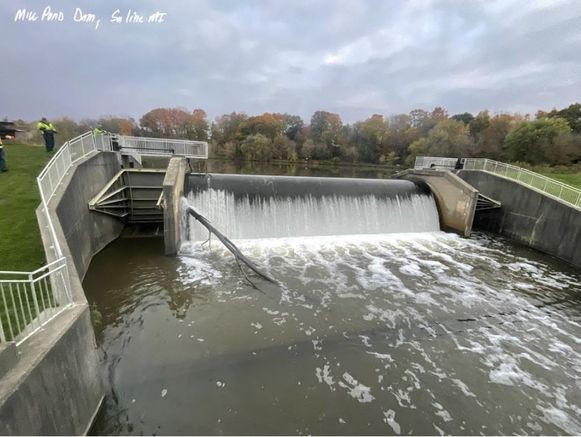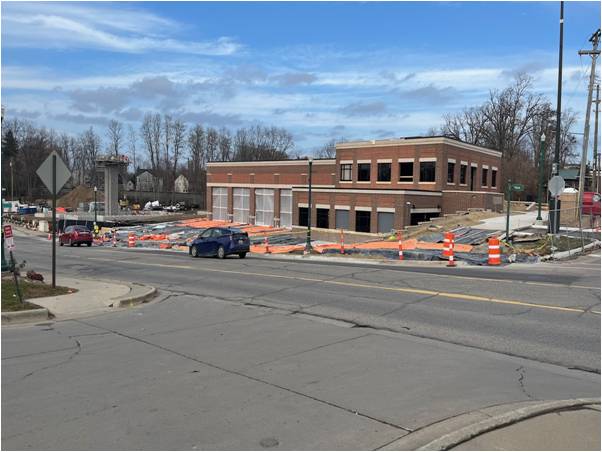Highlights from the report outlining key options, from costly repairs to full removal, detailing financial, environmental, and historical impacts for the community.
The City of Saline is evaluating whether to keep or remove the Saline River Dam. The dam does not appear to be at immediate risk of failure, but there are concerns about deterioration and future regulations.
The city recently posted its finalized 2025 March Feasibility Study prepared by the Spicer Group. The study can be found in the ClearGov documents on the city’s website. Key highlights of the 58-page report are below.
Background and Purpose of the Study
The report begins, “The City of Saline is taking a proactive approach to determining whether it is in its best interest to keep or remove the Saline River Dam. In its current state, the dam does not appear to be an imminent risk for failure. However, there are signs of deterioration that, if left unaddressed, will progress to the point that the City will have to act urgently and reactively, with less opportunity to deliberate on what is best for the City overall.”
And adds, “This study is not intended to recommend whether or not the Saline River Dam should be removed. The primary aim of this study is to provide the City with accurate information regarding what removal of the Saline River Dam would entail.”
The study focuses on evaluating five potential alternatives.
Options for Keeping the Dam
If the city decides to keep the dam, the study outlines two options:
- Rehabilitation
- Immediate cost: $1–1.5 million.
- Ongoing cost: $16,000 annually.
- “This alternative has the lowest immediate cost and has the least impact on the historical value of the dam.” However, “Although this alternative does reduce risk, the reduction of risk is minor compared to other available alternatives. Additional work will be required to keep risk of failure low and maintain operability of the dam, likely earlier than would be necessary with a newly reconstructed dam.”
- Replacement
- Immediate cost: $7–8 million.
- Ongoing cost: $16,000 annually.
- “This alternative accomplishes risk reduction to the greatest degree possible while still keeping a dam in place to impound Mill Pond.” However, “This is the most expensive option available and does not completely eliminate risk. Further, although the very existence of a dam in this historic location may hold some value, the value is significantly diminished when compared to maintaining the historic structure as it was constructed by Henry Ford.”
Options for Removing the Dam
If the city chooses removal, three conceptual alternatives were outlined:
- Remove the Saline River Dam and Curtiss Park Dam. Abandon the historic millrace. Restore the Saline River channel with a more natural gradient and provide a floodplain shelf in the area of the existing impoundment.
- Immediate cost: $4.5–5 million.
- Ongoing cost: $0-3,000 annually.
- This would restore the river to a “nearly natural state.”
- However, it may impact Wellers Weddings, a local business that relies on the millrace for its aesthetic and functional purposes. “Not only would abandoning the millrace have negative historical impacts, it may have direct impacts to the Wellers Weddings business operations. Because part of the millrace is on private property, it is unclear if modifications to the tail race, in particular, would be included in this alternative.”
- Remove the Saline River Dam and Curtiss Park Dam. Restore the Saline River channel in a highly controlled manner that ensures sufficient water surface elevation through the current impoundment area to provide water through the millrace. Modify the millrace inlet by lowering the weir and provide an auxiliary channel from the main river channel to the millrace inlet.
- Immediate cost:$4–5 million.
- Ongoing cost: “could be as low as $0.”
- “By modifying the Saline River channel in an unnatural way, there is still risk of failure present.” However, “This alternative seeks to mitigate the impacts to Wellers Weddings as much as possible while still removing the Saline River Dam. It also serves to preserve a portion of the historic value of the site that is not accomplished with Conceptual Alternative #1.”
- Remove the Saline River Dam and Curtiss Park Dam. Abandon the historic millrace inlet. Restore the Saline River channel with a more natural gradient and provide a floodplain shelf in the area of the existing impoundment. Construct an auxiliary channel or pipe south of US-12 to provide water to the historic trapezoidal tail race channel south of the Wellers Weddings building to maintain flow through the channel.
- Immediate cost: $5–6 million.
- Ongoing cost: “could be as low as $0.”
- This approach allows some water flow through historical channels while achieving ecological improvements. However, “creating a new diversion of water in the Saline River may not be viewed favorably by EGLE, making it potentially difficult to acquire a permit.”
All dam removal options involve additional considerations for sediment management, habitat restoration, and potential flooding impacts.
Community Impact and Public Engagement
The dam is historically significant, and removal or alteration would impact:
- Curtiss Park, Mill Pond, and Wellers Weddings.
- Water levels and floodplain management.
- Recreational opportunities (boating, fishing, and scenic views).
Public engagement included:
- A joint Parks and Environmental Commission meeting on September 19, 2023.
- A Town Hall meeting on December 9, 2024, where 37 attendees voiced opinions.
Next Steps for Saline
The city is in the early stages of decision-making and encourages public input. “We are simply acknowledging receipt and accepting the dam feasibility study that was presented this evening,” said Mayor Brian Marl at the March 17, 2025, City Council meeting. “We welcome additional feedback if you have it.”
City Engineer Tesha Humphriss also noted that dam removal projects typically take five to ten years to complete and that a final decision is not imminent. “We’re at the very first phase of public engagement,” she said, urging residents to review the feasibility study and submit feedback.



 8123 Main St Suite 200 Dexter, MI 48130
8123 Main St Suite 200 Dexter, MI 48130


